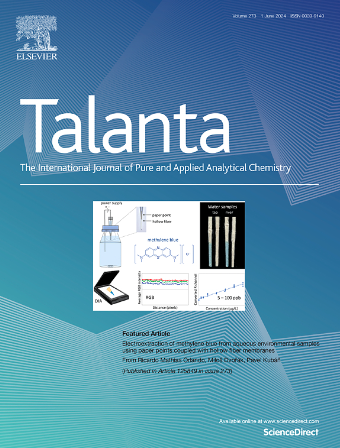烧毁和未烧毁纸张样本的机器学习辅助 LIBS 分类:法医学视角
IF 5.6
1区 化学
Q1 CHEMISTRY, ANALYTICAL
引用次数: 0
摘要
本文章由计算机程序翻译,如有差异,请以英文原文为准。

Machine Learning Assisted LIBS Classification of Burnt and Unburnt Paper Samples: A Forensic Perspective
A crucial part of investigating into a possible arson case is analyzing the chemical makeup of the fire's effects. In order to identify the chemical makeup of burnt materials that are frequently found in homes and businesses, the current study attempts to explore the potential of LIBS in forensic applications including burning of as well as forgery in paper-based documents. Various kinds of paper were chosen as a model sample to investigate the potential of Laser induced breakdown spectroscopy (LIBS) in forensics. First of all, LIBS spectra were recorded for unburnt samples by using Nd: YAG laser operated at 532nm, by optimizing the specific energy and delay between the laser pulse and shutter of the spectrometer, their elemental compositions were evaluated. The plasma parameters such as, plasma temperature, and electron number density were studied comprehensively to validate the local thermodynamic equilibrium condition. The three different kinds of ignition sources namely disposable lighter, candle, and gas stove were used to burn the sample to check the variation in elemental composition after the burning process for forensic applications as these sources are often present in homes and workplaces. The LIBS results suggest that all the samples have almost the same elemental composition even after using various kinds of ignition sources. Therefore, machine learning was applied to LIBS data by recording 100 datasets for each sample when ignited with different sources. PCA discriminates the samples slightly, but supervised machine learning algorithms LDA, QDA, and Linear SVM showed superior i.e., 100 % classification accuracies for various datasets that suggest the machine learning-assisted LIBS is a promising tool for forensic applications.
求助全文
通过发布文献求助,成功后即可免费获取论文全文。
去求助
来源期刊

Talanta
化学-分析化学
CiteScore
12.30
自引率
4.90%
发文量
861
审稿时长
29 days
期刊介绍:
Talanta provides a forum for the publication of original research papers, short communications, and critical reviews in all branches of pure and applied analytical chemistry. Papers are evaluated based on established guidelines, including the fundamental nature of the study, scientific novelty, substantial improvement or advantage over existing technology or methods, and demonstrated analytical applicability. Original research papers on fundamental studies, and on novel sensor and instrumentation developments, are encouraged. Novel or improved applications in areas such as clinical and biological chemistry, environmental analysis, geochemistry, materials science and engineering, and analytical platforms for omics development are welcome.
Analytical performance of methods should be determined, including interference and matrix effects, and methods should be validated by comparison with a standard method, or analysis of a certified reference material. Simple spiking recoveries may not be sufficient. The developed method should especially comprise information on selectivity, sensitivity, detection limits, accuracy, and reliability. However, applying official validation or robustness studies to a routine method or technique does not necessarily constitute novelty. Proper statistical treatment of the data should be provided. Relevant literature should be cited, including related publications by the authors, and authors should discuss how their proposed methodology compares with previously reported methods.
 求助内容:
求助内容: 应助结果提醒方式:
应助结果提醒方式:


